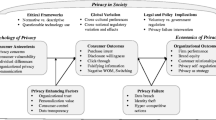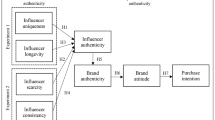Abstract
Using daily scanner data we analyze consumers’ reactions to negative information with regard to product quality with reference to a fraud that involved a number of leading Italian firms in the cheese sector in 2008. We evaluate the effects of this event by using a difference-in-differences estimation strategy that compares the brands that were involved in the fraud with those that were uninvolved. It emerges that the negative news with regard to product quality induced consumers to shift their demand from involved to not involved brands. These effects persisted over time, even after the media stopped giving attention to the issue. Retailers suffered part of the costs of the bad news about product quality: the retail margin on brands that were mentioned adversely by the media decreased after the negative publicity.
Similar content being viewed by others
References
Askitas N., Zimmermann K. (2009) Google econometrics and unemployment forecasting. Applied Economics Quarterly 55(2): 107–129
Bertrand, M., Duflo, E., & Mullainathan, S. (2004). How much should we trust differences-in-differences estimates. Quarterly Journal of Economics, 119(1), 249–274.
Borenstein S., Zimmerman M. (1988) Market incentives for safe commercial airline operation. American Economic Review 78(5): 913–935
Burton M., Dorsett R., Young T. (1996) Changing preferences for meat: Evidence from UK household data, 1973–93. European Review of Agricultural Economics 23(3): 357–370
Chalk A. J. (1987) Market forces and commercial aircraft safety. Journal of Industrial Economics 36(1): 61–81
Chevalier J., Kashyap A., Rossi P. (2003) Why don’t prices rise during periods of peak demand? Evidence from scanner data. American Economic Review 93(1): 15–37
Choi, H., & Varian, H. (2009). Predicting initial claims for unemployment benefits, Google technical report.
D’Amuri, F., & Marcucci, J. (2009). Google it! Forecasting the US unemployment rate with a Google job search index, ISER, University of Essex.
Dahlgran R., Fairchild D. (2002) The demand impacts of chicken contamination publicity—a case study. Agribusiness 18(4): 459–474
Darby M., Karni E. (1973) Free competition and the optimal amount of fraud. Journal of Law and Economics 16(1): 67–70
DellaVigna, S. (2009). Psychology and economics: Evidence from the field, Journal of Economic Literature, 47(2), 315–372.
Garber, S., & Adams, J. (1998). Product and stock market responses to automotive product liability verdicts, Brookings Papers on Economic Activity, Microeconomics, pp. 1–53.
Ginsberg J., Mohebbi M., Patel R., Brammer L., Smolinski M., Brilliant L. (2009) Detecting influenza epidemics using search engine query data. Nature 457: 1012–1014
Jarrell G., Peltzman S. (1985) The impact of product recalls on the wealth of sellers. Journal of Political Economy 93(3): 512–536
Klein B., Leffler K. (1981) The role of market forces in assuring contractual performance. Journal of Political Economy 89(4): 615–641
Nelson P. (1974) Advertising as information. Journal of Political Economy 82(4): 729–740
Prince D., Rubin P. (2002) The effects of product liability litigation on the value of firms. American Law and Economics Review 4(1): 44–87
Schlenker W., Villas-Boas S. (2009) Consumer and market responses to mad-cow disease. American Journal of Agricultural 91(4): 1140–1152
Shapiro C. (1983) Optimal pricing of experience goods. Bell Journal of Economics 14(2): 497–507
Shimshack J., Ward M., Beatty T. (2007) Mercury advisories: Information, education, and fish consumption. Journal of Environmental Economics and Management 53(2): 158–179
Smith M., van Ravenswaay E., Thompson S. (1988) Sales loss determination in food contamination incidents: An application to milk bans in Hawaii. American Journal of Agricultural Economics 70(3): 513–520
Suhoy, T. (2009). Query indices and a 2008 downturn, Bank of Israel Discussion Paper.
Takaoka S. (2004) Verdicts and the value of the firm in Japan. Economics Letters 84(1): 93–97
Viscusi W., Hersch J. (1990) The market response to product safety litigation. Journal of Regulatory Economics 2(3): 215–230
Author information
Authors and Affiliations
Corresponding author
Additional information
We would like to thank Antonio Ventriglia for providing access to the data, the Editor Lawrence White and two anonymous referees, Alessandra Antonelli, Antonio Nicita, Michela Ponzo, and participants at the 38th Annual Conference of the European Association for Research in Industrial Organization, Stockholm 1–3 September 2011, for useful comments and suggestions.
Rights and permissions
About this article
Cite this article
De Paola, M., Scoppa, V. Consumers’ Reactions to Negative Information on Product Quality: Evidence from Scanner Data. Rev Ind Organ 42, 235–280 (2013). https://doi.org/10.1007/s11151-012-9365-5
Published:
Issue Date:
DOI: https://doi.org/10.1007/s11151-012-9365-5




